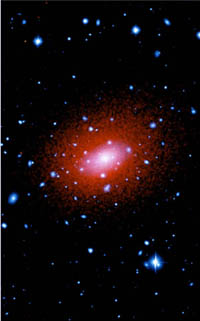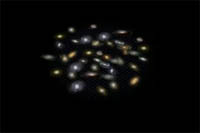Chandra Opens New Line Of Investigation On Dark Energy
Astronomers have detected the mysterious dark energy by
applying a powerful, new method that uses images of galaxy
clusters made by NASA's Chandra X-ray Observatory. The
results trace the transition of the expansion of the universe
from a decelerating phase to an accelerating phase that occured
several billion years ago.
"Dark energy is perhaps the biggest mystery in physics," said
study leader Steve Allen of the Institute of Astronomy (IoA)
University of Cambridge, England. "As such, it is extremely
important to make an independent test of its existence and
properties," he said.

|
This optical (blue) and NASA's Chandra X-ray (red-orange) composite image shows Abell 2029, a cluster of galaxies. A large elliptical galaxy is visible in the center of the image, surrounded by smaller galaxies. The red diffuse emission shows hot intergalactic gas, heated to about 100 million degrees by the enormous gravity in the cluster, and visible only in X-rays.
(Optical: NOAO/Kitt Peak/J.Uson, D.Dale; X-ray: NASA/CXC/IoA/S.Allen et al.)
|
Allen and his colleagues used Chandra to study 26 clusters of
galaxies which lie between one and eight billion light
years away from Earth. These data span the time when the universe
initially slowed from its original expansion, but then expanded
rapidly because of the repulsive effect of dark energy.
"We're directly seeing that the expansion of the universe is
accelerating by measuring the distances to these galaxy
clusters," said IoA scientist and study co-author Andy
Fabian. "The new Chandra results suggest the dark energy
density does not change quickly with time and may even be
constant, consistent with the "cosmological constant" concept
first introduced by Albert Einstein," he said. If so, the Universe is
expected to continue expanding forever, so that in billions of years
only a tiny fraction of the known galaxies will be visible.
If the dark energy is constant, more dramatic fates for the
universe would be avoided. These include the "Big Rip,"
where dark energy increases until galaxies, stars, planets
and, finally, even atoms are torn apart, and the "Big
Crunch," where the universe eventually collapses on itself.
Chandra's probe of dark energy uses X-ray observations to
detect and study the hot gas in galaxy clusters. From these
data, the ratio of the mass of the hot gas to the mass of the
dark matter in a cluster can be determined. The observed values of the
gas fraction depend on the assumed distance to the cluster. This
distance in turn depends on the curvature of space and the amount of
dark energy in the universe.
Since galaxy clusters are so large, they are thought to represent a
fair sample of the matter content of the universe. If so, the
relative amounts of hot gas and
dark matter should be the same for every cluster. Using this
assumption, Allen and colleagues adjusted the distance scale to
determine which one fit the data best. They derived distances that show
the expansion of the universe was first decelerating, but
began to accelerate about six billion years ago.
 |
This animation (1.5 MB) shows the
expansion history of the Universe. The Big Bang is immediately
followed by rapid expansion of the Universe. This expansion then slows
down because of the gravitational attraction of the matter in the
Universe. The expansion speeds up again because of the effect of
dark energy.
(Credit: NASA/STScI/G. Bacon)
|
Chandra's observations agree with observations of distant
supernovae, including those from NASA's Hubble Space
Telescope (HST), which first showed dark energy's effect on
the acceleration of the universe. Chandra's results are
completely independent of the supernova technique. This independent
verification helps to dispel any remaining doubts that the supernova
technique might be flawed.
"Our Chandra method has nothing to do with other techniques,
so we're definitely not comparing notes, so to speak," said
Robert Schmidt of the University of Potsdam, Germany, another
co-author of the study.
Better limits on the amount of dark energy, and how it varies
with time, are obtained by combining the X-ray results with
data from NASA's Wilkinson Microwave Anisotropy Probe (WMAP).
WMAP used observations of the cosmic microwave background
radiation to discover evidence for dark energy in the very
early universe. Using the combined data, Allen and his
colleagues found dark energy makes up about 75% of
the universe, dark matter about 21%, and ordinary
matter about 4%.

|
The new Chandra observations include estimates of the total energy content of the Universe. As shown in this illustration, dark energy is estimated to contribute about 75% of the energy in the Universe, dark matter about 21% and normal matter about 4%. Only the normal matter can be directly detected with telescopes, and about 85% of this is hot, intergalactic gas, as detected in Chandra observations of galaxy clusters.
(Credit: NASA/CXC/M.Weiss)
|
Allen and his colleagues stress that the uncertainties in the
measurements are such that the data are consistent with dark energy
having a constant value. The present Chandra data do, however, allow
for the possibility that the dark energy density is increasing with
time. More detailed studies with Chandra, HST, WMAP and future X-
ray missions like Constellation-X, should provide much more
precise constraints on dark energy.
"Until we better understand cosmic acceleration and the
nature of the dark energy, we cannot hope to understand the
destiny of the universe," said Michael Turner, assistant
director for mathematical and physics sciences, National
Science Foundation, Arlington, Va.
The research team also included Harald Ebeling of the
University of Hawaii and the late Leon van Speybroeck of the
Harvard-Smithsonian Center for Astrophysics. These results
appear in an upcoming issue of the Monthly Notices of the
Royal Astronomy Society.
Additional Links
 Visit the Chandra X-ray Observatory Center. (http://chandra.harvard.edu/) Visit the Chandra X-ray Observatory Center. (http://chandra.harvard.edu/)
 Read more Chandra X-ray Observatory news. (http://chandra.nasa.gov/) Read more Chandra X-ray Observatory news. (http://chandra.nasa.gov/)
|
